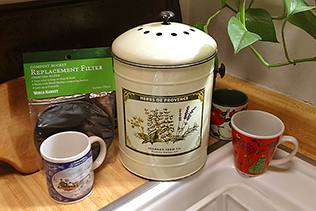"I consider every plant hardy until I have killed it myself."
— Sir Peter Smithers
4/11/16:
I've been spending lots of time out in the yard on the weekend or evenings, but indoor gardening-related endeavors are also in progress. One new houseplant, a curly lipstick plant, was an impluse buy when visting my favorite garden store. It apparently needs a decent amount of light, high humidity, and likes to be watered with warm water. Hardly low-maintenance, but very cute, so I don't (yet) regret buying it. I hope to help it survive by taking it down from the hook near a skylight where light is weak and indirect, and placing it on the south-facing windowsill for a few hours on sunny days. I've been misting this one and the spider plant with the spray bottle I use for the chameleon's enclosure.
I finally found a container that's just the right size and shape I wanted for building my first terrarium. I took a lot of pictures at each stage of putting it together, so I'll select a few of those, write up a description of the steps as a tutorial, and share it here soon.
Clicking on the small images below will bring up a larger version.

Lipstick plant.

Terrarium components.

Compost can in the kitchen.
I've gathered a new clump of seaweed from the beach at the end of our street. I wash it a bit to remove excess salt and sand, then put it in a covered container outside to break down. It'll be a watery mush that I can use as fertilizer in about a month.
I'm experimenting further with composting. I've used coffee grounds since last growing season, sprinkling a bit on the top of the dirt around plants to provide nitrogen and hopefully repel pests. I also mixed crushed seashells into the soil a few times to add texture and calcium (similar effect from eggshells). But there are benefits from composting other usually-discarded materials from the house and yard as well, so I'm figuring out what's practical and easy to implement. I bought a kitchen compost canister at Cost Plus World Market this past weekend; I think it will fill up quickly. In only two days we have realized how much of what normally went in the trash can is compostable: coffee grounds, asparagus stalks, eggshells, avocado peel, and wilted houseplant leaves. Soon I'll start a compost pile out in the yard. From what I've read online, the best method might be to find a place to dig a pit and then cover the compost with soil to keep raccoons out.







